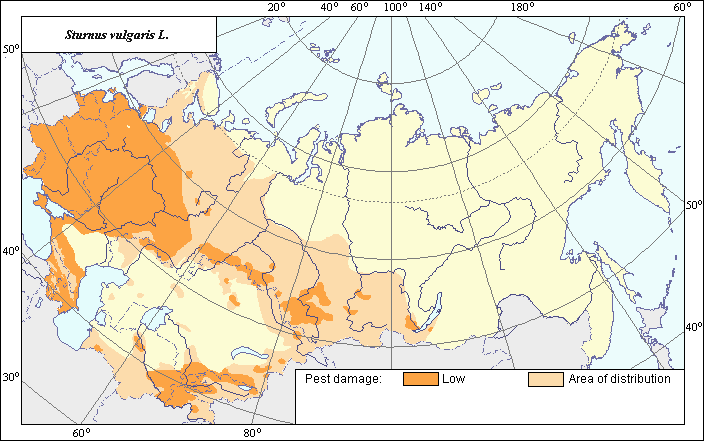Pests
Area of distribution and damage of Sturnus vulgaris L.
 Object description Download GIS-layers
Object description Download GIS-layers
Authors:
Biologist specialist - F.A.Karlik,GIS-specialist - M.I.Saulich.
Date of creation:
19.05.2006.Scale:
1:20 000 000.Accuracy of the map:
It is created on materials of maps of natural scale 1:33 000 000 - 1:80 000 000.Projection:
"Alber's Equal Area Conic for the USSR", 9, 1001, 7, 100, 0, 44, 68, 0, 0.Basic content:
Vector map, consisting of 2 thematic layers where area of distribution and zone of damage are shown by polygons.Accuracy of the classifier:
Within the area of S. vulgaris, the zone of damage is marked where harming activity of this species regularly reaches economically significant yield losses of fruit and berry crops (above 3-5%).Method of map production:
The area of distribution of S. vulgaris is established according to 4 open published maps. It is based on the map of nesting and wintering of S. vulgaris after the publication of U.N.G. von Blotzheim (1993) as the most detailed. The most part of the area in this publication coincides with the map from the monograph of G.P.Dementyev et al. (1954). At the same time, there are some differences in the views on the eastern limit of distribution of S. vulgaris. According to G.P.Dementyev et al. (1954), this part of the limit is shown rather sketchy in comparison with the later and more detailed map from U.N.G. von Blotzheim (1993). The most northern part of the limit, going through Kola Peninsula, is also shown by U.N.G. von Blotzheim (1993) and additionally corrected by S.Cramp & C.M.Perrins (1994). Thus, the general tendency has been recorded in moving this species northward as a result of global climate warming during the last decades. In Central Asia, areas in Turkmenistan and Uzbekistan are shown by the monograph of G.P.Dementyev et al. (1954), comprising floodplain of Amu-Darya to Aral Sea. In all other respects, the configuration of the area in this region reflects the absence of this species in arid zones and coincides with the limits of distribution after U.N.G. von Blotzheim (1993). The limits of the zone of low damage are established by the analysis of the publications by the specialists-ornithologists, who performed long-term observations in different geographical regions. Such observations and estimation of harming activity of S. vulgaris were conducted in NorthWest and Central parts of Russia (Golovanova, 1975; 1980), in Moldavia (Donika et al., 1961), in Kazakhstan and Kirghizia (Sema, 1975; Troitskii, 1948), in Uzbekistan (Pavlenko, Kashkarov, 1967). The zone of damage was corrected by the maps of distribution and industrial growing of berry crops according to the vector maps from Agroatlas (Koroleva et al., 2003; Doronina et al, 2005).Reference citations:
Beme, R.L. & Kuznetsov, A.A. 1966. Birds of forests and mountains of the USSR (field key). Moscow: Prosveshcheniye. 272 p. (in Russian).Blotzheim, von U.N.G., ed. 1993. Handbook of Middle European birds [Handbuch der Vogel Mitteleuropas]. Bd 13/III. Wiesbaden: AULA-Verlag. P. 1371.2178.
Cramp, S. & Perrins, C.M., ed. 1994. Handbook of the Birds of Europe, the Middle East, and North Africa (The Birds of the Western Palearctic). Vol. VIII. Oxford-New York: Oxford University Press.
Dementyev, G.P., Gladkov, N.A., Sudilovskaya, A.M., Spangenberg, E.P., Beme, L.B., Volganetskii, I.B., Voinstvenskii, M.A., Gorchakovskaya, N.N., Korelov, M.N. & Rustamov, A.K. 1954. Birds of the USSR. V.5. Moscow: Sovetskaya Nauka. 803 p. (in Russian).
Donika, I.S., Ganya, I.M. & Yakubanis, V.N. 1961. The experiments on starling scaring. Sadovodstvo, vinogradarstvo i vinodelie Moldavii 2: 63-65 (in Russian).
Flint, V.E., Beme, R.L., Kostin, Yu.V. & Kuznetsov, A.A. 1968. Birds of the USSR (reference keys for geographer and traveler). Moscow: Mysl. 637 p. (in Russian).
Golovanova, E.N. 1975. Birds and agriculture. Leningrad: Lenizdat. 168 p. (in Russian).
Golovanova, E.N. 1980. Methodical recommendations on the use of insectivorous birds in arable lands, prevention of their harm and protection of endangered species. Leningrad: VASKHNIL, VIZR. 46 p. (in Russian).
Pavlenko, T.A. & Kashkarov, D.Yu. 1967. New data on flight and feeding of Sturnus vulgaris in Golodnaya Steppe (Uzbekistan). In: K.V. Arnoldi, ed. Ecology of mammals and birds. Moscow: Nauka: 293-295.
Sema A.M. 1975. The biology of the Europen Starling in the south-east of Kazakhstan and the reduction of its harmfulness in vineyards. PhD Abstr. Alma-Ata: Kazakh State Univ. 25 p. (in Russian).
Troitskii, G.A. 1948. Starlings - harmful birds on vineyards in Kazakhstan and Kirghizia. Vinodeliye i vinogradarstvo v SSSR 1: 34-35 (in Russian).
Right and copyright:
All rights reserved. Copyright 2006© F.A.Karlik & M.I.Saulich.Picture was taken from Gladkov, N.A., Dementyev, G.P., Mikheev, A.V. & Inozemtsev, A.A. 1970. The life of animals. V. 5. (Birds). Moscow: Prosveshcheniye. 611 p. (in Russian).

